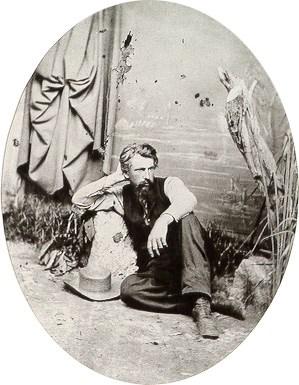Andrew J. Russell (1829–1902) grew up in the northeast pursuing the life of an artist. As he progressed artistically, he received numerous commissions from political and railroad figures to paint portraits, along with landscapes. He slowly moved into photography by using photos as references for his paintings instead of creating sketches. His move toward photography would not only alter his career, but would alter our view of American history.

Although he spent most of his life in the northeast―New York, specifically―he is remembered most for his time in the West during its expansion. His name, or more accurately, his images, would forever be linked with the Transcontinental Railroad. Before construction began, however, Russell found himself commissioned for a destructive cause: the Civil War.
When the Civil War initially broke out, Russell used his talents to promote recruitment for the Union Army. Motivated by the Union cause, he helped form the local 141st New York Volunteers militia in 1862. Early in 1863, he met Egbert Guy Fowx, a photographer for Mathew Brady’s studio. Fowx mentored Russell in his skills as a photographer and, shortly thereafter, Russell was assigned to Army Engineer General Herman Haupt’s U.S. Military Railroad Construction Corps. His assignment was to create a visual record of Haupt’s construction projects.
As an official government photographer stationed in Virginia, he was also assigned to take photos of battlefields and campsites. For a lengthy period of time, many of Russell’s Civil War photos were mistakenly identified as belonging to Brady. Only relatively recently has the record been corrected. Russell remained as Haupt’s photographer and was also promoted to quartermaster for the Railroad Construction Corps until Sept. 9, 1865.
In the middle of the Civil War, construction for the Transcontinental Railroad began. Russell had spent several years capturing the country tear itself apart between North and South. Once the war ended, Russell had the opportunity to capture the country coming together from East to West. At war’s end, Russell was hired as the official photographer for the Union Pacific Railroad.

He photographed the progress of the railroad construction from Laramie, Wyoming, to Promontory Summit, Utah. His most famous work is indeed one of the most famous moments and famous photographs in American history. When the Central Pacific and the Union Railroad lines came together at Promontory Summit, Russell snapped the photo. The photograph is known as “East and West Shaking Hands at Laying Last Rail.”
In 1869, Union Pacific Railroad published a book of Russell’s photographs entitled “The Great West Illustrated.” When Russell’s commission with the railroad ended two years later, he returned to New York, opened his own studio, and never returned to the West.






